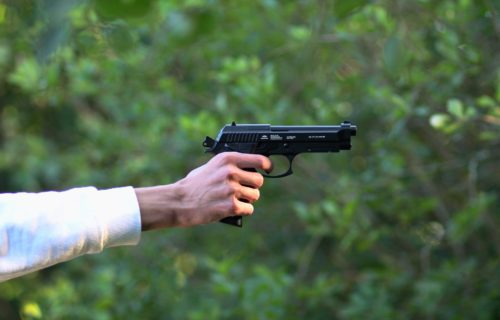BOSTON — The United States has a long and bloody history of gun violence that seems to get worse when the sun is shining. Now, a new study by Boston researchers has found a clear association between warmer weather and firearm violence in 100 of the country’s most populated cities. Heat-related shootings could be an underrated but deadly nationwide problem, the experts suggest.
“Our study provides strong evidence that daily temperature plays a meaningful role in gun violence fluctuations,” says senior author Jonathan Jay, assistant professor of community health sciences at Boston University School of Public Medicine, in a media release. “Even though some regions showed larger or smaller effects, the general pattern is remarkably consistent across cities.”
Gun violence is the leading cause of death among children and teens, with government officials recording a spike in shootings during the pandemic. In the current study, the authors found that seven percent of gun violence had a link to above-average daily temperatures. The Northeast and Midwest regions had the highest shooting rates on hotter-than-normal days. With climate change increasing global temperatures, the study authors urge that policies and programs are necessary to reduce the risk of heat-related gun violence.
“Our study really highlights the importance of heat adaptation strategies that can be used all year, as well as a need for specific regional awareness and attention in regions where this relationship is strongest,” says lead author Vivian Lyons, a research scientist in the Social Development Research Group at the University of Washington’s School of Social Work.
Regardless of temperature, hotter days led to more shootings
The research team collected information from the Gun Violence Archive, a national database of gun violence history. They took note of the daily temperatures on the day of the over 116,000 shootings from 2015 to 2020. The data captured shootings from the top 100 U.S. cities with the highest number of assault-related shootings. Previous research has only studied firearm violence in a few cities, making it difficult to get a picture of gun violence nationwide.
Taking seasonality and regional climate differences into account, the study authors found 7,973 shootings occurring on days with above-average temperatures. Although the temperature rise differed across cities. For example, Seattle and Las Vegas experienced the most gun violence on days when temperatures rose into the 96th percentile range of average daily temperatures. However, the 96th percentile for Seattle was 84 degrees. In Las Vegas, it was 104 degrees.
“Cities with high rates of firearm violence should continue to implement firearm-prevention strategies broadly including credible messenger programs and hospital-based violence intervention programs,” explains Dr. Lyons. “What our study suggests is that for cities with more heat-attributable shootings, implementing heat adaptation strategies at the community level—such as greening efforts that have been effective at reducing urban heat islands and have some association with reductions in firearm violence—may be particularly important.”
Why do hotter days lead to more gun violence?
Researchers are not too sure, but they have some theories. Dr. Jay proposes it may have to do with heat causing stress, making people moodier and more aggressive. Another idea is that people are more likely to go outside on warmer days and socialize, which breeds opportunities for conflict and violence.
“Most likely, it’s a combination of both,” Jay says.
If you’re looking at the data by region, the study authors hypothesize that gun violence may occur on the hottest days in the Northeast and Midwest because people there are less used to the heat. Additionally, those regions are more likely to be racially segregated than other areas of the country.
“The Northeast and Midwest regions are where we see some of the starkest differences in the built environment and other resources, according to race—to me, these inequities are the most interesting and important direction of this work,” Jay continues. “We know that segregation and disinvestment lead communities of color, especially Black communities, to have greater exposure to adverse environmental conditions that contribute to gun violence risks, such as abandoned buildings, liquor stores, lack of green space, and more intense urban heat islands.”
Heat mitigation strategies such as planting trees for shade in urban areas are some ways to offset racial inequalities in neighborhoods and potentially reduce gun violence. Dr. Jay says that “these are all urgent issues where we need to continue to partner with communities and work across disciplines.” Future research will focus on heat-related gun violence among neighborhoods to see the difference in shooting rates.
The study is published in JAMA Network Open.


Are you people for real? Get a life.